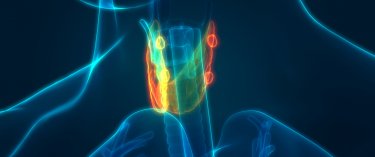
Thyroid Cancer
What is thyroid cancer?
An increasingly common cancer
The thyroid cancer rate has been climbing constantly in France and in most Western countries since the 1970s.
According to data provided by Santé Public France, the number of cases in men went from 325 in 1980 to 1,599 in 2005, while in women the number of cases rose from 1,027 in 1980 to 5,073 in 2005. These figures are not correlated with an increased mortality rate. In fact, the number of deaths has decreased by around 400 per year.
Women are more exposed than men to the disease, which is generally diagnosed between the ages of 30 and 50.
According to the experts at Santé Public France, the increased incidence of thyroid cancer is mainly due to improved early diagnosis techniques and the more widespread use of surgical practices, rather than to the Chernobyl nuclear accident, often suspected by the general public.
Thyroid cancer risk factors
We don’t know the causes of thyroid cancer, only the risk factors. This type of cancer occurs more frequently in patients with a very low iodine intake, and in those who have been exposed to radiation either accidentally or for medical reasons.
Detection of a nodule
The detection of a nodule almost always leads to a more in-depth examination of the thyroid to determine whether or not cancer has developed.
Nodules can be discovered in a variety of ways:
- A lump in the lower area of the neck that moves on swallowing but does not cause discomfort
- More and more often, the accidental discovery of a small nodule during a medical imaging exam (such as a Doppler or neck ultrasound) performed for other reasons
- A lymph node in the neck; an increase in the size of a known goiter; difficulty swallowing; a change in the voice; a persistent, unexplained cough
Detection of thyroid cancer
Thyroid cancer can be identified using a range of exams:
- Neck palpation (done by the patient or the physician)
This is the simplest and most direct exam available to assess the characteristics of the thyroid gland and possibly detect a goiter or nodule.
- Lab tests
A blood test to measure the T3, T4 and TSH hormones and detect any abnormal production rates.
- Ultrasound: the gold standard
A neck ultrasound provides essential information about any nodules present, including their quantity, size, and whether they are solid or fluid-filled. It is also used to examine the lymphatic chains in the neck.
- Fine needle aspiration cytology: an important nodule examination
This practically pain-free, safe procedure (often performed under ultrasound guidance) consists in collecting cells from a nodule using a fine needle. The sample is placed between two glass slides and analyzed under a microscope.
- Scintigraphy: less common today
This exam consists in intravenously injecting a radioactive product (isotope of technetium or iodine) that binds to the patient’s thyroid. The patient then lies down on their back and a camera positioned above the patient detects the radiation emitted by the radioactive product. “Warm” or “cold” nodules show up on the image depending on whether or not they bind to the radioactive isotope.
Thyroid cancer treatment
Treatment takes place in several steps:
- Surgery
The surgeon performs a thyroidectomy, i.e. a complete ablation of the thyroid gland. This is the surest way to prevent the tumor from growing and to facilitate additional treatments and follow-up care.
- Thyroxine (T4) therapy is then necessary to compensate for the absence of the thyroid.
- Iodine-131
This radioisotope is used to eliminate any remaining normal and, most importantly, cancerous thyroid remnants.
It is not administered when the post-operative risk of relapse is very low.
Iodine-131 is given after stimulation of the thyroid by TSH. This stimulation occurs either after a prolonged period of hypothyroidism or following an injection of recombinant human TSH produced in a laboratory. This increases the quantity of circulating TSH without interrupting the patient’s Levothyroxâ treatment. Recombinant TSH is administered by intramuscular injection for two days in a row; on the third day, the patient receives the iodine-131.
Prognosis
When thyroid cancer is detected early, the prognosis for recovery is close to 100 percent. However, this depends on several other parameters:
- In adults, the risk of relapse increases with the size of the tumor and the patient’s age. In children, relapses are relatively frequent.
- Life expectancy depends on the age at which the cancer metastasizes. For example, the risk of death is higher in patients over 65.
Screening
Screening is very important:
- When there is a genetic predisposition
- When the patient has undergone radiation for breast cancer: a thyroid ultrasound should be performed at the same time as the follow-up mammogram
- In regions that are underexposed to iodine, particularly Eastern France
